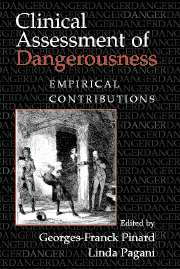Book contents
- Frontmatter
- Contents
- Contributors
- Prologue
- Introduction
- Basic Issues in Violence Research
- Mental Health Issues and Dangerousness
- Family Issues and Dangerousness
- Individual Characteristics and Dangerousness
- 11 Alcohol and Dangerousness
- 12 Violence and Substance Abuse
- 13 Threats, Stalking, and Criminal Harassment
- Conclusion
- Index
12 - Violence and Substance Abuse
Published online by Cambridge University Press: 03 July 2009
- Frontmatter
- Contents
- Contributors
- Prologue
- Introduction
- Basic Issues in Violence Research
- Mental Health Issues and Dangerousness
- Family Issues and Dangerousness
- Individual Characteristics and Dangerousness
- 11 Alcohol and Dangerousness
- 12 Violence and Substance Abuse
- 13 Threats, Stalking, and Criminal Harassment
- Conclusion
- Index
Summary
Introduction
For these purposes violence can be defined as behavior by persons against other persons that intentionally threatens, attempts, or actually inflicts physical harm (Reiss & Roth, 1993, p. 35). It does not include self-inflicted harm as in suicide, nor verbal abuse, harassment, or psychological humiliations in which trauma may occur. Nor does it include unintentional harm, whether to self or others, which may result from taking contaminated or unusually pure substances leading to an overdose and perhaps death. Substance abuse means using illegally controlled substances but can include alcohol.
Interest in the links between violence and substance abuse has been prompted by increasing awareness that drug markets are violent places where death is commonplace and violence a standard feature of street dealing. In Britain and elsewhere, the introduction of crack cocaine in the late 1980s led to a more fearful yet considered formulation of the existing position. Low-level crack dealers were seen to display firearms on the streets of British cities where firearms were hitherto unknown. A product of this change has been to develop strategies for intervention and control, which have included a renewed research activity aimed at explaining some of the complexities between violence and substance abuse (de la Rosa, 1990). Another has been to alert policy makers to use research to help control a burgeoning industry of drug trafficking and supply.
Too often, however, the strategies required for intervention have been threatened by defects in existing data. Some have been longstanding, others recent.
- Type
- Chapter
- Information
- Clinical Assessment of DangerousnessEmpirical Contributions, pp. 216 - 237Publisher: Cambridge University PressPrint publication year: 2000
- 1
- Cited by



